We included HMH Into Math Grade 7 Answer Key PDF Module 5 Lesson 1 Understand Multiplication and Division of Rational Numbers to make students experts in learning maths.
HMH Into Math Grade 7 Module 5 Lesson 1 Answer Key Understand Multiplication and Division of Rational Numbers
I Can evaluate expressions and solve real-world problems involving rational number multiplication and division.

Spark Your Learning
Arnot wins a $50 gift card for a virtual reality arcade. If he does not use the card for a whole year, the balance on the card will be reduced by $5 each month that it continues to go unused. What will be the change in the value of the card if Arnot doesn’t use it for 18 months?
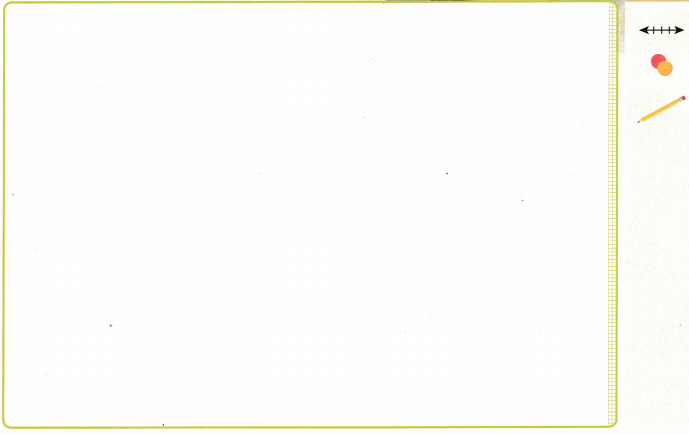
Answer:

Arnot wins $50 gift card
If he does not use the card for a whole year the balanced is reduced by $5 each month
1 year = 12 months
= 12 × -5
= -$60
The change in value if Arnot doesn’t use it for 18 months is
= $18 × -5
= -$90
Turn and Talk Did you use the same method? If not, explain your reasoning to make sure both methods are correct.
Build Understanding
1. Jordan is scuba diving and stops each time she descends 15 feet to take a photo. Starting at the surface, she does this 4 times until she reaches her final depth. What is her overall change in elevation?

Answer:
Jordan descends 15 feet to take a photo
= -15 × 4
= -60 feet
A. What number represents each change in elevation?
_______________________
Answer:
– 15 feet.
B. Use the number line to model Jordan’s entire descent.
_______________________
C. Write an addition expression to represent your model.
_______________________
Answer:
15 + 15 + 15 + 15 + 15
D. Write a multiplication expression to represent your model.
The number line shows arrows moving ___ units ___ times. That means the multiplication expression would be ___ (___).
Answer:
The number line shows arrows moving 15 units 4 times. That means the multiplication expression would be – 60.
E. How should the value of the addition expression in Step C compare to the value of the multiplication expression in Step D? Explain your reasoning.
__________________________
F. Make a conjecture about the result of multiplying a negative number by a positive number. Explain your reasoning.
__________________________
__________________________
Answer:
Multiplying a negative number by a positive number we get negative number.
(-) × (+) = (-)
Example:
-10 × +5 = -50
G. Use your conjecture in Step F to complete the last column in the table indicating the sign of the product pq.
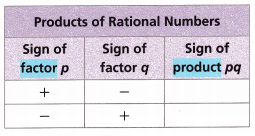
Answer:

H. Complete the rule for multiplication of rational numbers with different signs. +
The product of two rational numbers with different signs is a ___ number.
I. What is Jordan’s overall change in elevation?
Answer:
Jordan’s overall change in elevation is -60 feet.
Turn and Talk Steps A- E support the first rule in the Products of Rational Numbers table. Which mathematical property supports the second rule? Explain your reasoning.
Answer:
Commutative property.
Explanation:
The mathematical property that supports the second rule is called the Commutative property.
a + b = b + a for addition
a × b = b × a for mutiplication
2. In order for operations like multiplication to work with negative numbers the same way they work with positive numbers, the operations have to satisfy the properties of operations.
A. Use the rule you wrote in the first task to complete the following.
3(6 + (-4)) = 3(6) + 3(___)
3(2) = 18 + (____)
6 = ___
Answer:
3(6 + (-4)) = 3(6) + 3(___)
3(6 + (-4)) = 3(6) + 3(-4)
3(2) = 18 – 12
6 = 6
B. What property is being applied in the first equation in Step A? Does applying the rule for multiplying numbers with different signs give the correct result? Why or why not?
__________________________
__________________________
Answer:
The property is applied in the first equation in Step A is called Associative property.
Applying this rule for multiplying numbers with different signs gives the correct result.
C. Complete the following to make the statements true. Explain how you figured out the answer.
-3(6 + (-4)) = (-3)(6) + (-3)(-4)
-3(2) = -18 + ___
-6 = -6
This means that -3(-4) = ___.
__________________________
__________________________
Answer:
-3(6 + (-4)) = (-3)(6) + (-3)(-4)
-3(2) = -18 + 12
-6 = -6
This means that -3(-4) = 12.
By solving the given expression and by using the BODMAS rule.
Solve the numbers which are braces (6 + (-4)) =(6 – 4) = 2
– × – = + so (-3)(-4) = 12
D. Complete the table.

Answer:

E. Write a rule for multiplication of rational numbers with the same sign. The product of two rational numbers with the same sign is a ___ number.
(+) × (+) = (+)
The product of two rational numbers with the same sign is a positive number.
Turn and Talk Write another example like the example in Step C to show why the product (-5)(-4) must be equal to 20.
Answer:
The product of two rational numbers with the same sign is a positive number.
the product (-5)(-4) must be equal to 20.
(-) × (-) = (+)
(-5) × (-4) = 20
3. You can use what you know about multiplying signed numbers to figure out the rules for dividing signed numbers. In multiplication, if one factor is 0, the product will be 0. In division, the divisor cannot be 0. Division by 0 is undefined.
A. Use the fact that division and multiplication are inverse operations to complete the number statements in the table.
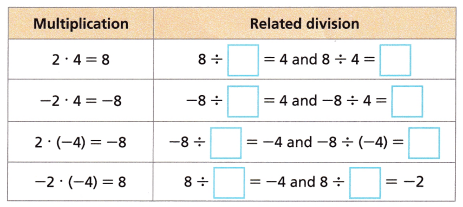
Answer:

B. Use your results from Step A to complete the table.
C. Complete the rules for division of rational numbers.
- The quotient of two rational numbers with different signs is a ________ number.
The quotient of two rational numbers with different signs is a negative number. - The quotient of of two rational numbers with the same sign is a ____ number.
The quotient of two rational numbers with the same sign is a positive number.
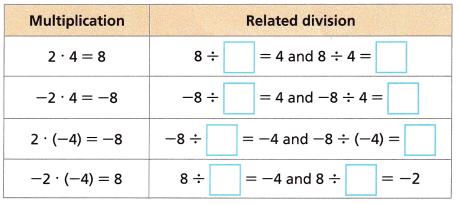
Answer:

Check Understanding
Question 1.
Kaleb’s football team lost 2 yards on each of 3 consecutive plays. Complete the statement to represent the change in position relative to the line of scrimmage after these three plays. How does this example show that the product of a positive number and a negative number is negative?
3(___) = -2 + (-2) + (-2) = ___
Answer:
They lost total of 6 yards.
Explanation:
They lost 2 yards on every 3 consecutive plays.
That means the change is 6 yards.
Question 2.
How can you use the equation in Problem 1 to illustrate that the quotient of two negative numbers is positive?
Answer:
The quotient of two negative numbers is a positive rational number.
Explanation:
Let us take -3 and -2 as an example
If we multiply – × – we get positive
-3 × -2 = 6
Question 3.
Compare the rules for finding the signs of products and quotients.
Answer:
The sign rules are the same for the multiplication and division of numbers. And multiplication can also be expressed as division.
Example: a × b and a ÷ b
On Your Own
Model with Mathematics Model the situation with a multiplication and an addition expression involving negative numbers. Then evaluate.
Question 4.
Every day that Annabelle takes the train to work, she uses an app to charge the parking fee shown to her credit card. What will be her card balance for commuter parking if she parks and takes the train to work 10 times?
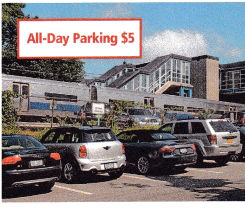
Answer:
$50
Explanation:
All a day parking is $5. So 10 times bill is 10 × $5 = $50
Question 5.
Alejandro makes donations in the amount of $100 every December to 5 of his favorite charities. He pays for the donations by check. What is the change in his checking account balance after making these donations?
Answer:
$500
Explanation:
The donation will reduce his checking account balance by $500.
Use Repeated Reasoning Complete the statements. Explain how you figured out the answer.
Question 6.
8(-5 + 7) = 8(-5) + 8(7)
8(2) = ___ + 56
16 = 16
This means that 8(-5) = ___
Answer:
-40
Explanation:
Given,
8(-5 + 7) = 8(-5) + 8(7)
8(-5) = -40
8(2) = -40 + 56
16 = 16
(+) + (-) = (-)
This means that 8(-5) = -40
Question 7.
-2(-5 + 9) = -2(-5) + (-2(9))
-2(4) = ___ + (-18)
-8 = -8 This means that -2(-5) = ___
Answer:
10
Explanation:
Given,
2(-5 + 9) = -2(-5) + (-2(9))
-2(-5) = 10
-2(4) = _10__ + (-18)
-8 = -8
This means that -2(-5) = 10
(-) × (-) = (+)
Identify the sign of the product or quotient. Do not evaluate.
Question 8.
253 × (-185)
________
Answer:
The sign of the product is –
Question 9.
-59 × 819
________
Answer:
The sign of the product is (-).
Question 10.
-1,200 × (-490)
________
Answer:
The sign of the product is (+).
Question 11.
1,242 ÷ (-18)
________
Answer:
The sign of the Quotient is (-).
Explanation:
Given,
1,242 ÷ (-18)
The product of (+) × (-) = (-).
Question 12.
-1,890 ÷ (-15)
________
Answer:
The sign of the product is (+).
Explanation:
Given,
-1,890 ÷ (-15)
The product of (-) × (-) = (+).
Question 13.
-18,175 ÷ 125
________
Answer:
The sign of the product is (-).
Explanation:
Given,
-18,175 ÷ 125
The product of (-) × (+) = (-).
Explanation:
Given,
-18,175 ÷ 125
The product of (-) × (+) = (-).
Question 14.
Complete each step to show that (-1)(-1) = 1.
(-1)(0) = ____
(- 1)(- 1 + 1) = 0 Addition Property of opposites
(- 1)(- 1) + (- 1)(1) = 0
(- 1)(- 1) + ___ = 0 Identity Property of Multiplication
(- 1)(- 1) + (- 1) + ___ = 0 + ___
(- 1)(- 1) + (- 1 + 1) = 0 + 1
(- 1)(- 1) + ___ = 0 + 1 Addition Property of Opposites
(- 1)(- 1) = ___ Identity Property of Addition
Answer:
(-1)(0) = 0
(- 1)(- 1 + 1) = 0 Addition Property of opposites
(- 1)(- 1) + (- 1)(1) = 0
(- 1)(- 1) + 0 = 0 Identity Property of Multiplication
(- 1)(- 1) + (- 1) + 0 = 0 + 0
(- 1)(- 1) + (- 1 + 1) = 0 + 1
(- 1)(- 1) + 0 = 0 + 1 Addition Property of Opposites
(- 1)(- 1) = 1 Identity Property of Addition
Question 15.
The value of a collectible baseball card decreased as shown.
A. Use Tools To find the average monthly change in the value of the card, use the number line to find -12 ÷ 6.
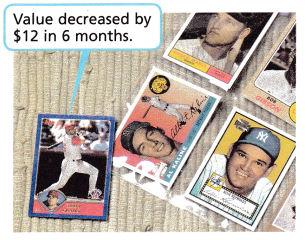

-12 ÷ 6 = ___
_______________________
Answer:
-2
Explanation:
Given,
-12 ÷ 6
By dividing the given expression the answer is -2.
B. Construct Arguments What is the sign (positive or negative) of the quotient? Explain why this makes sense in the context of the problem.
_______________________
_______________________
Answer:
The sign of the quotient is (-). From the given question after dividing the expression the resultant will be negative.
Question 16.
Open Ended Write a different division problem involving negative numbers that can be solved using the number line given in Problem 15.
Answer:
let us assume the negative numbers is
-14 ÷ -7 = 2
-10 ÷ -2 = 5
I’m in a Learning Mindset!
How can I use my understanding of rational number multiplication to help support my understanding of rational number division?
Lesson 5.1 More Practice/Homework
Model with Mathematics For Problems 1 and 2, model the situation with a multiplication and an addition expression involving negative numbers. Then evaluate.
Question 1.
After a gymnastics competition, the coaches reviewed all the gymnasts’ scores to identify areas for improvement. A missed landing on an aerial cartwheel deducts 2 points from the score. The coaches found that aerial cartwheels were missed 5 times across the competition. How did these missed landings affect the scores overall?
Answer:
10 points will be deducted.
Explanation:
A missed landing on an aerial cartwheel deducts 2 points from the score.
The coaches found that aerial cartwheels were missed 5 times across the competition
Hence 5 × 2 = 10 points would be deducted.
Question 2.
The temperature fell by 3°F every hour during a 6-hour period. What was the overall change in temperature during the 6-hour period?
_______________________
Answer:
18 degrees
Explanation:
The temperature fell by 3°F
the time period is 6 hour
The overall change in temperature during the 6-hour period is 3 × 6 = 18 degrees.
Question 3.
Use Repeated Reasoning Complete the statements. Explain.
-4(5 + (-2)) = (___) (5) + (___) (-2)
-4(___) = -20 + ___ This means that (-4)(-2) = ___
-12 = -12
_______________________
_______________________
Answer:
(-4)(-2) = 8
Explanation:
Given,
4(5 + (-2)) = (_4_) (5) + (_-4_) (-2)
-4(_3_) = -20 + _8_ This means that (-4)(-2) = _8_
-12 = -12
Identify the sign of the product (positive or negative). Do not evaluate.
Question 4.
-819 × (-324)
Answer:
The sign of the product is (+).
Explanation:
The multiplication of (-) × (-) = (+)
Question 5.
-1,201 × 54
Answer:
The sign of the product is (-).
Explanation:
The multiplication of (-) × (+) = (-)
Question 6.
10,005 × (-84)
Answer:
The sign of the product is (-).
Explanation:
The multiplication of (+) × (-) = (-)
Question 7.
Construct Arguments Dario said that if the dividend and divisor have the same sign, then the quotient also has that same sign. Do you agree or disagree? Explain.
Answer:
I disagree.
Explanation:
If the dividend and divisor are positive numbers a quotient is a positive number.
Example: 2 ÷ 2 = 1
If the dividend and divisor are negative numbers the quotient is a positive number.
Example: -5 ÷ -5 = 1
Question 8.
Use Structure Explain how you can use the fact that multiplication and division are inverse operations to help you determine whether the quotient -10 ÷ (-5) is positive or negative.
Answer:
-10 ÷ (-5) = 2 is positve.
Explanation:
Multiplying and dividing by the same number does not change the original number.
For example (11 × 6) ÷ 6 = 11. And the given quotient -10 ÷ (-5) = 2 is positive.
Test Prep
Question 9.
Which quotients are negative? Select all that apply.
A. \(\frac{-52}{13}\)
B. 14 ÷ (-2)
C. -36 ÷ (-9)
D. \(\frac{-20}{-5}\)
E. -27 ÷ 3
F. \(\frac{7}{-1}\)
Answer:
A. \(\frac{-52}{13}\)
B. 14 ÷ (-2)
E. -27 ÷ 3
F. \(\frac{7}{-1}\)
The options which are selected quotients are negative.
Question 10.
Marley’s bank charges a $3 service fee each time money is withdrawn from another bank’s ATM. Marley is traveling and must withdraw money from another bank’s ATM 4 times. Which expressions model the change in the balance of her account due to the service fees? Select all that apply.
A. -3 + (-3) + (-3) + (-3)
B. -4 + (-4) + (-4) + (-4)
C. 4 × (-3)
D. -4 × (-3)
E. 3 × 4
Answer:
C. 4 × (-3)
Explanation:
Marley’s bank charges a $3 service fee
He must withdraw money ATM 4 times.
4 × (-3)
Question 11.
An equation is shown.
a ∙ b = c
Which statement is true?
A. If a > 0 and b > 0, then c < 0. B. If a > 0 and b < 0, then c < 0.
C. If a < 0 and b > 0, then c > 0.
D. If a < 0 and b < 0, then c < 0.
Answer:
C. If a < 0 and b > 0, then c > 0.
Explanation:
The statement that is true is option C.
C. If a < 0 and b > 0, then c > 0.
Spiral Review
Question 12.
Miguel takes $50 to the mall. He buys a flannel shirt for $18.99 and a hat for $12.49. On his way home, he stops at the bank and withdraws $25. How much money does Miguel have now?
Answer:
$43.52
Explanation:
Given,
He buys a flannel shirt = $18.99
And a hat = $12.49
$18.99 + $12.49 = $31.48
$50 – $31.48 = $18.52
$25 + $18.52 = $43.52
Question 13.
A store marks up its inventory 45%. The wholesale price of an item was $130. What is the retail price of the item?
Answer:
The retail price of the item is 188.5.
Explanation:
Form the given question, find
130 × (1 + 45%)
Calculate the expression
130 × 1.45
188.5
Question 14.
Stephanie has a -$40 balance on her credit card. She makes two additional charges to pay $20 for gas and $25 for parking. Then she makes a credit card payment of $30. What is her remaining balance?
Answer:
$25 left
Explanation:
She has a total of $40
She makes two additional charges to pay $20 for gas and $25 for parking.
Credit card payment of $30
= $30 – $25
= $5
On the card, she has a balance of $25.